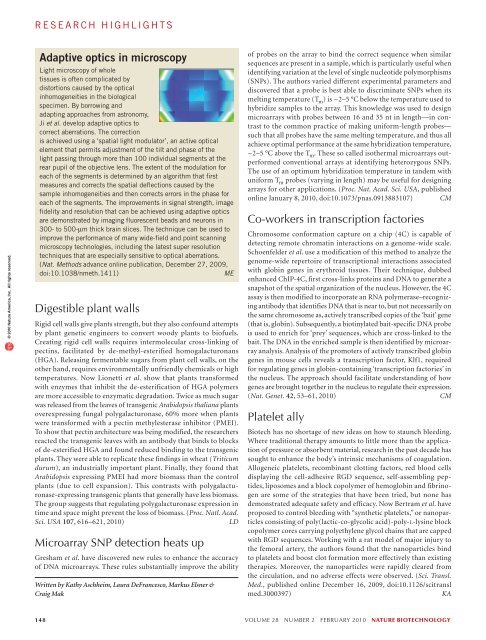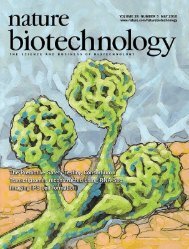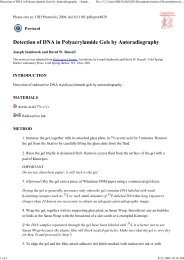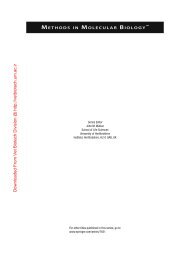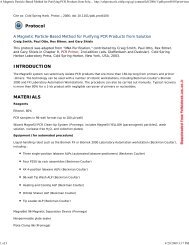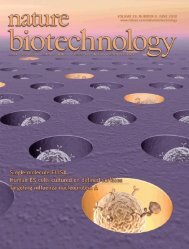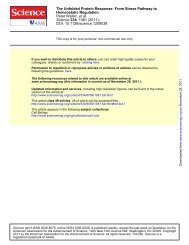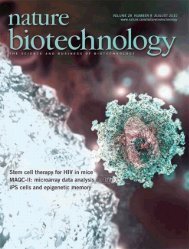Ontology engineering
Ontology engineering
Ontology engineering
Create successful ePaper yourself
Turn your PDF publications into a flip-book with our unique Google optimized e-Paper software.
esearch highlights© 2010 Nature America, Inc. All rights reserved.Adaptive optics in microscopyLight microscopy of wholetissues is often complicated bydistortions caused by the opticalinhomogeneities in the biologicalspecimen. By borrowing andadapting approaches from astronomy,Ji et al. develop adaptive optics tocorrect aberrations. The correctionis achieved using a ‘spatial light modulator’, an active opticalelement that permits adjustment of the tilt and phase of thelight passing through more than 100 individual segments at therear pupil of the objective lens. The extent of the modulation foreach of the segments is determined by an algorithm that firstmeasures and corrects the spatial deflections caused by thesample inhomogeneities and then corrects errors in the phase foreach of the segments. The improvements in signal strength, imagefidelity and resolution that can be achieved using adaptive opticsare demonstrated by imaging fluorescent beads and neurons in300- to 500-µm thick brain slices. The technique can be used toimprove the performance of many wide-field and point scanningmicroscopy technologies, including the latest super resolutiontechniques that are especially sensitive to optical aberrations.(Nat. Methods advance online publication, December 27, 2009,doi:10.1038/nmeth.1411)MEDigestible plant wallsRigid cell walls give plants strength, but they also confound attemptsby plant genetic engineers to convert woody plants to biofuels.Creating rigid cell walls requires intermolecular cross-linking ofpectins, facilitated by de-methyl-esterified homogalacturonans(HGA). Releasing fermentable sugars from plant cell walls, on theother hand, requires environmentally unfriendly chemicals or hightemperatures. Now Lionetti et al. show that plants transformedwith enzymes that inhibit the de-esterification of HGA polymersare more accessible to enzymatic degradation. Twice as much sugarwas released from the leaves of transgenic Arabidopsis thaliana plantsoverexpressing fungal polygalacturonase, 60% more when plantswere transformed with a pectin methylesterase inhibitor (PMEI).To show that pectin architecture was being modified, the researchersreacted the transgenic leaves with an antibody that binds to blocksof de-esterified HGA and found reduced binding to the transgenicplants. They were able to replicate these findings in wheat (Triticumdurum), an industrially important plant. Finally, they found thatArabidopsis expressing PMEI had more biomass than the controlplants (due to cell expansion). This contrasts with polygalacturonase-expressingtransgenic plants that generally have less biomass.The group suggests that regulating polygalacturonase expression intime and space might prevent the loss of biomass. (Proc. Natl. Acad.Sci. USA 107, 616–621, 2010)LDMicroarray SNP detection heats upGresham et al. have discovered new rules to enhance the accuracyof DNA microarrays. These rules substantially improve the abilityWritten by Kathy Aschheim, Laura DeFrancesco, Markus Elsner &Craig Makof probes on the array to bind the correct sequence when similarsequences are present in a sample, which is particularly useful whenidentifying variation at the level of single nucleotide polymorphisms(SNPs). The authors varied different experimental parameters anddiscovered that a probe is best able to discriminate SNPs when itsmelting temperature (T m ) is ~2–5 °C below the temperature used tohybridize samples to the array. This knowledge was used to designmicroarrays with probes between 16 and 35 nt in length—in contrastto the common practice of making uniform-length probes—such that all probes have the same melting temperature, and thus allachieve optimal performance at the same hybridization temperature,~2–5 °C above the T m . These so called isothermal microarrays outperformedconventional arrays at identifying heterozygous SNPs.The use of an optimum hybridization temperature in tandem withuniform T m probes (varying in length) may be useful for designingarrays for other applications. (Proc. Nat. Acad. Sci. USA, publishedonline January 8, 2010, doi:10.1073/pnas.0913883107) CMCo-workers in transcription factoriesChromosome conformation capture on a chip (4C) is capable ofdetecting remote chromatin interactions on a genome-wide scale.Schoenfelder et al. use a modification of this method to analyze thegenome-wide repertoire of transcriptional interactions associatedwith globin genes in erythroid tissues. Their technique, dubbedenhanced ChIP-4C, first cross-links proteins and DNA to generate asnapshot of the spatial organization of the nucleus. However, the 4Cassay is then modified to incorporate an RNA polymerase–recognizingantibody that identifies DNA that is near to, but not necessarily onthe same chromosome as, actively transcribed copies of the ‘bait’ gene(that is, globin). Subsequently, a biotinylated bait-specific DNA probeis used to enrich for ‘prey’ sequences, which are cross-linked to thebait. The DNA in the enriched sample is then identified by microarrayanalysis. Analysis of the promoters of actively transcribed globingenes in mouse cells reveals a transcription factor, Klf1, requiredfor regulating genes in globin-containing ‘transcription factories’ inthe nucleus. The approach should facilitate understanding of howgenes are brought together in the nucleus to regulate their expression.(Nat. Genet. 42, 53–61, 2010)CMPlatelet allyBiotech has no shortage of new ideas on how to staunch bleeding.Where traditional therapy amounts to little more than the applicationof pressure or absorbent material, research in the past decade hassought to enhance the body’s intrinsic mechanisms of coagulation.Allogeneic platelets, recombinant clotting factors, red blood cellsdisplaying the cell-adhesive RGD sequence, self-assembling peptides,liposomes and a block copolymer of hemoglobin and fibrinogenare some of the strategies that have been tried, but none hasdemonstrated adequate safety and efficacy. Now Bertram et al. haveproposed to control bleeding with “synthetic platelets,” or nanoparticlesconsisting of poly(lactic-co-glycolic acid)-poly-l-lysine blockcopolymer cores carrying polyethylene glycol chains that are cappedwith RGD sequences. Working with a rat model of major injury tothe femoral artery, the authors found that the nanoparticles bindto platelets and boost clot formation more effectively than existingtherapies. Moreover, the nanoparticles were rapidly cleared fromthe circulation, and no adverse effects were observed. (Sci. Transl.Med., published online December 16, 2009, doi:10.1126/scitranslmed.3000397)KA148 volume 28 number 2 february 2010 nature biotechnology


